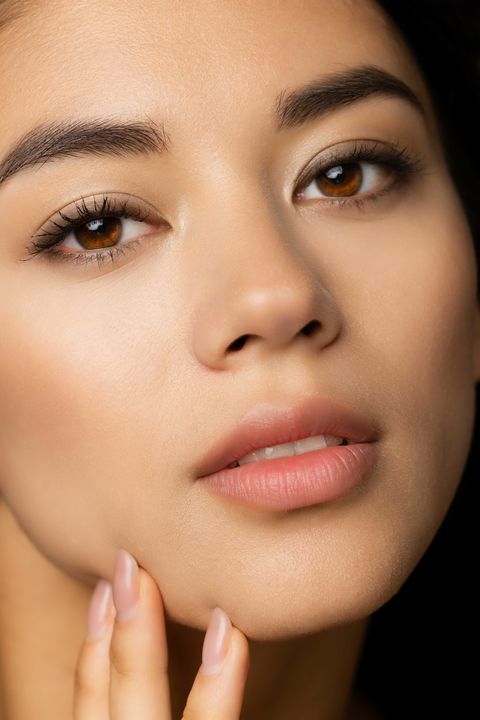Once upon a time (or like 40 years ago), facial injections were to most people what the smartphone is to my 90-year-old landlord — an appealing but mostly baffling innovation. To be fair, neuromodulators were hardly water-cooler talk outside of medical circles until the early ‘80s, when pioneering ophthalmologist Dr. Jean Carruthers began using them to treat facial muscle spasms. Before that, they had only just started to be used as a treatment for strabismus, aka crossed eyes, in the 1970s.
In fact, it was these very medicinal treatments that led to the discovery of their aesthetic benefits, bolstered specifically by the collaborative work between Dr. Carruthers and her husband, dermatologist Dr. Alastair Carruthers. Together, they published a culture-shifting scientific paper and pioneered the cosmetic use of injections that many still swear by to achieve and/or maintain a youthful beauty standard.
In hindsight, it should be unsurprising that non-invasive cosmetic treatments have only grown in popularity over the past two years. According to participants in a recent insights and trends report by the American Society of Plastic Surgeons, most patients are not only willing to spend more on cosmetic procedures and treatments than they did before the pandemic, but their motivations are also a direct result of social distancing and the so-called “Zoom Boom.”
Yes, the temporary shutdown of in-person businesses ignited an embrace of pared down makeup routines. At the same time, a perfect storm of people constantly checking themselves out on computer cameras, reimagined discretionary income, and WFH policies left many wanting to make swift (and subtle) changes, while also erasing the physical stress marks of pandemic anxiety.
That same study confirms botulinum toxin injections are the most popular minimally invasive treatment today, especially among people under the age of 45 who, more than anything, view it as preventative. This type of neurotoxin, more widely known under popular brand names, including Xeomin and Botox, blocks nerve signals to certain muscles so they don’t contract, and subsequently, delay and/or diminish signs of aging—think smile lines, crow’s feet, and brow lines.
Given that it’s practically synonymous with beauty goals, the pharmaceutical beginnings of botulinum toxin injections aren’t discussed as often, even though its medical perks are just as apparent. As a result, BoNT injections, in general terms, are sometimes mislabeled as superficial and unnecessary.
Even less discussed are the ways they continue to provide reprieve for people with unrelenting health challenges, such as multiple sclerosis
People with chronic illnesses sometimes exchange advice and support through online communities, so testimonials about the benefits of neuromodulators are common in popular Reddit channels for people with the nervous system disease. In their cases, Botox can feel like a miracle cure for many symptoms, a result of myelin damage in the brain, spine, and even optic nerves.
“For muscle spasms and muscle spasticity there is increased activity causing muscles to contract or tighten more than they should. Botox loosens the muscles to decrease pain and discomfort,” according to Dr. Mitzi Joi Williams, MD, FAAN, a neurologist, MS Specialist and founder of Joi Life Wellness Group ,
Overactive bladder is another common MS symptom, as the bladder itself can become spastic or lesions can block signals to that part of the body, leading to a sense of urgency, incontinence, nocturia, and/or an inability to properly empty the bladder. “Botox weakens the muscles to give them more time to get to the restroom once they get the ‘urge’ to do so,” she explains.
The beauty of these injectables, adds Williams, is that because many patients respond well, “they may be able to reduce or discontinue other medications which could be causing additional side effects.” Still, there are some caveats. In terms of timing. Botox only provides temporary relief – on average, there months – and it can take 6-12 weeks to become effective.
“Patients should let their doctors know if they have ever had an allergic reaction to any Botox products in the past or if they have any respiratory issues such as asthma, as Botox can affect breathing in some rare cases,” cautions Williams. “Also, they should let the doctor know if they have any weakness in muscles of the face or other neurologic conditions that could be affected by injections. Finally, they should not get injections if they have an infection.”
Thankfully, these treatments have FDA approval for MS and other medical conditions. Dr. Sheila Farhang, MD, Board-Certified dermatologist, and founder of Avant Dermatology & Aesthetics, confirms this, citing Xeomin in particular as an FDA-approved treatment for cervical dystonia, or painful neck muscle contractions, and blepharospasm, or abnormal contractions of the eye muscle.
BoNT injections are also FDA approved to treat temporomandibular joint dysfunction
More popularly known as “TMJ,” it impairs the movement of the jaw and its surrounding muscles. For those living with this condition, it can create aching pains in the mouth and ears, make chewing or opening/closing the mouth difficult, and cause teeth grinding, the latter of which can negatively impact the teeth’s appearance too.
Pain relievers, mouth guards, and physical therapy may provide temporary relief but for many, injections deliver longer-lasting results. Though it’s unsurprisingly administered by dentists, board-certified dermatologists like Dr. Farhang will sometimes offer the service as well, since the injection placement is like those administered for cosmetic purposes. Board-certified dermatologists are also trained to know the ins and outs of these joints, even if they aren’t always directly treating them.
[Editor’s Note: And it should go without saying that non-invasive treatments should always be done by professionals with the proper medical accreditation and licenses.]
Injecting Botox into the affected jaw muscles, in layman’s terms, causes them to not work as hard, thus releasing the tension caused by TMJ and providing relief. Facial injections are generally safe but there is still a small risk of injury or unpleasant results, especially if administered by a non-professional and/or without a thorough medical assessment beforehand.
For example, Dr. Farhang has seen patients receive “way too many units for what is indicated safe” – 15-20 units are typical for mild TMJ cases – or have Botox injected into the wrong place, “hitting the risorius muscle (aka muscle used for smiling) instead of the masseter,” thus causing the person “to not be able to smile or other facial expressions.”
Like those administered for MS symptoms, this type of injection also doesn’t deliver instant results. TMJ-specific Xeomin or Botox treatment takes a little time to kick in, usually around a couple of weeks. “It’s not as simple as relaxing the muscle for wrinkles. Equate this to working out your biceps and then not doing that work out any longer,” says Farhang.
On the upside, TMJ patients only need this treatment 1-2 times per year, should they be satisfied with the results. Generally speaking, the effects of the neurotoxin will wear off after 3-4 months but unlike wrinkles, it will take some time after that for a bulk of the treated muscle to feel like it’s ready for reinforcement. But ultimately, the frequency of treatments is specific to the individual.
Neuromodulators are also used to treat excessive sweating, medically called hyperhidrosis
According to Dr. Hayley Leight-Dunn, MD, Board-Certified Dermatologist at Dermatology, Laser, and Vein Specialists of the Carolinas, “many physicians use [FDA-approved Botox] and other neuromodulator medications off-label for sweating in the hands, feet, scalp, and other body locations.”
Because BoTN injections block the release of acetylcholine, the neurotransmitter responsible for telling sweat glands to produce sweat, the decreased signaling ultimately brings sweat production to more amiable levels. For people with hyperhidrosis, these glands never take time off, which causes them to be overstimulated and create excess perspiration. Injections accomplish what deodorant never could, though it should be noted that like the other medical-specific injections, results may not be immediate.
Dr. Leight-Dunn adds that “neuromodulator injections only work in the area they are used,” so for example, “injections in the underarm does not help with excessive sweating on the sole of the foot.” Botulinum injection as hyperhidrosis treatment is also generally safe, though pain and mild injection site reactions, such as bruising, redness, or swelling may happen.
Additionally, “injections are slightly more painful when done on the palms and soles of the feet,” according to Leight-Dunn, “and your physician may want you to use a topical numbing medication before the procedure.” Decreased muscle strength is another risk factor to note when considering this treatment but as with all medical procedures, results and risk factors depend partly on the individual’s condition and needs.
Generally speaking, BoTN injections are sometimes eligible for healthcare coverage, though that depends on a number of different factors, including where you live and the type of insurance you have. According to Dr. Williams, some manufacturers may offer patient assistance programs too. Out of pocket fees may depend on those same factors, but in general, the price is usually at least $1,000 per treatment.
Outside of treatment for physical ailments, there is also emerging research around botulinum injections as a viable treatment for depression
For example, a 2015 case report by Dr. Farhang, published in the SciMedCentral Journal of Dermatology and Clinical Research, shares anecdotal evidence that relieving tension in the forehead via botulinum injections may also help improve mood.
The study patient presented with multiple self-induced skin lesions on his forehead and scalp, tension headaches, and “an inability to relax.” Prior to receiving facial injections in his forehead, he was given wound care and an antidepressant, both of which only provided partial relief.
However, three weeks after receiving botulinum injections, his symptoms completely resolved, though he continued with some treatments for maintenance. Still, there are multiple factors that could explain its effectiveness.
“Tension headaches may have been a trigger for his picking response, and thus eliminating the headaches may have resulted in a suppression of his urges to pick. BoNT may also have reduced a hyperalgesic state by either eliminating the headaches or by a direct analgesic effect on the afferent nerves,” explains Dr. Farhang.
“Manipulation of other mediator’s of pain and itch pathways may have also contributed to a decreased urge to excoriate the areas that were injected. Finally, it is possible that BoNT also played a role in treating his underlying depression in association with his antidepressant medication. Any of these mechanisms may be playing an important role in this condition and further studies are warranted to investigate specific pathways,” she adds.
Those findings have been expanded upon in more recent years, as botulinum injections are more frequently cited alongside other alternative therapies, including ketamine transfusions, as a mood-stabilizing treatment as unexpected as it was a wrinkle treatment in the ‘80s.
According to a 2020 Scientific Reports study: “The results of the analysis indicate that patients who received BoNT injections to treat hyperhidrosis, facial wrinkles, migraine prophylaxis, spasticity, and spasms, had a significantly lower number of depression reports when compared to patients undergoing different treatments for the same conditions. These findings suggest that the antidepressant effect of BoNT is significant, and, surprisingly, is observed for a broad range of injection sites.”
Studies like this expose the interconnectedness of physical and psychological symptoms, and how either can potentially benefit through treatment of the other. It shows the need for a healthcare system that prioritizes a more integrated approach to patient care, where prevention takes priority and symptoms aren’t always considered and/or treated in isolation from the rest of the body.
“I do believe that injectables will continue to grow in use in medical practice,” adds Dr. Williams. “Oftentimes people may not respond well to traditional therapies or not be able to tolerate them due to side effects such as drowsiness, etc. Procedures will decrease some of the daily burden of pill taking and other untoward effects.”
Ultimately, BoNT injections are so much more than the aesthetic perks they provide. In fact, they’re breaking barriers that are anything but skin-deep.




